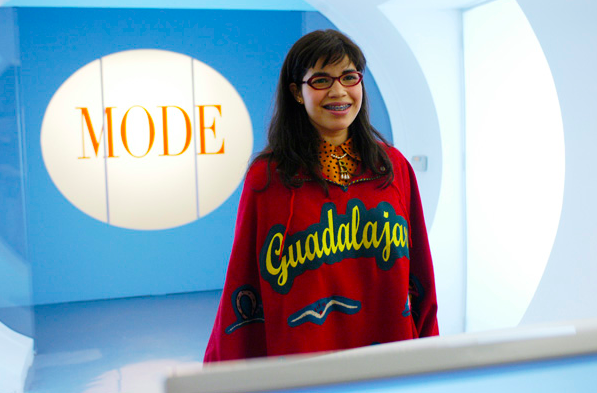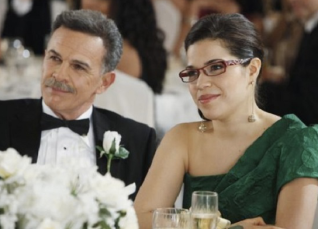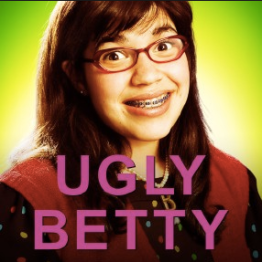Ugly Betty was a show on NBC from 2006 to 2010. The Wikipedia description of the show states, “The series focuses on the life of wannabe writer Betty Suarez, a plain girl from Queens, N.Y., who is smart, hardworking and savvy but has a different sense of style. When publishing mogul Bradford Meade puts his son Daniel in charge of his Mode magazine, he hires Betty to be Daniel’s new assistant — mostly because he knows that she may be the only woman in Manhattan with whom the younger man won’t sleep.” The show portrays Betty (America Ferrera) as a dowdy character who does not fit into the glamorous world where she now finds herself. 
The show won critical acclaim in its first year. Madeline Shufeldt Esch wrote, “In its first year, Ugly Betty garnered significant media attention for its telenovela roots (adapted from the Colombian hit Yo Soy Betty la Fea (I Am Betty the Ugly, 1999-2001), big-name backers (Salma Hayek is an executive producer), sensitive portrayal of a working-class Mexican American family, and its sincere embrace of gay and transgender characters. Moreover, the show’s apparent willingness to challenge conventional notions of beauty was championed by audiences and television critics” (Esch 2010, 169).
While the show’s exploration of gender and cultural issues are worthy of discussion, I am particularly interested in Ugly Betty’s treatment of societal expectations pertaining to beauty and appearance. This series labels Betty as ugly, but facilitates her transformation and assimilation into white fashion culture. The apparent message is that Betty must manage her appearance to become accepted by viewers and her peers. The show reinforces typical standards of beauty; it merely reflects the expected image of one who belongs in the world of elite fashion.

In first episode of the show, Betty appears for her first day of work wearing braces and glasses. She sports a mop of “frizzy” hair and a green poncho with the word Guadalajara written across the chest. The receptionist appears to doubt her understanding of English and speaking slowly to her and asks if she is delivering something. Betty steps away and tries to encourage herself by stating, “You are an attractive, intelligent confident business woman” and then walks face first into the door. The “comedy” of Betty’s entrance juxtaposes that she is determined and will succeed, but will need to adapt to fit into the glamorous world of publishing. Guillermo Avila-Saavedra discusses how “the show articulates a tension between ethnic “otherness” and cultural assimilation that symbolizes current negotiations of individual and collective identities among young, English-speaking Latinos in the United States” (Avila-Saavedra 2010, 1). The show navigates between Betty’s work and family life. We see her ongoing transformation within the workplace while she continues to return to and support her unchanged Mexican-American family.

The last episode of the series reveals the transformation of Betty. The poncho is gone having been replaced by a form fitting dress, revealing Betty’s weight loss. The Franko et al. study found that her weight loss appeared to be “an attempt to minimize her traditional Latina physique. While she still holds a healthy, ‘curvy’ figure, she is significantly smaller than she once was” (Franko et al. 2012, 3). Betty’s metamorphosis is further developed by replacement of the large rimmed glasses by sleek, clear eyeglasses, straight teeth minus the brace and straight hair with slight curls. At this point, Betty’s appearance tells us that she now belongs to the glamorous world of publishing.
Throughout the show, Betty fights to find success in her work life. In the final episode, she decides to move to London for a new career. We see that Betty wishes to move on from the judgmental behavior of her coworkers and start anew. Apparently, Betty believes that she will experience success and happiness with this new image, which is more in line with traditional notions of beauty.
 Betty’s changed appearance is not the only change that we observe by the time of the final episode. We also see, despite the dismay of her father, a loosening of the traditional family ties as she decides to move away from New York. While both Betty and her sister lived with their father throughout most of the series, by the time of the final episode, Betty is ready to be on her own and explore uncharted territory. During the series Betty “navigated across multiple terrains at home, at work and at play” (Ruiz 1998, 67).
Betty’s changed appearance is not the only change that we observe by the time of the final episode. We also see, despite the dismay of her father, a loosening of the traditional family ties as she decides to move away from New York. While both Betty and her sister lived with their father throughout most of the series, by the time of the final episode, Betty is ready to be on her own and explore uncharted territory. During the series Betty “navigated across multiple terrains at home, at work and at play” (Ruiz 1998, 67).

However, by the final episode, Betty is ready for a new environment despite the fact that she is leaving family in her wake. Vicki Ruiz discusses the way that American consumerism transformed the Latina family structure. In the last episode, Betty is provided haggis (an entrée composed of internal sheep organs) rather than the traditional Mexican food prepared by her father. While it was not an easy decision for Betty to move away from her family, she is demonstrating to the viewer that she has fully transitioned from her past to her new more glamorous life of the elite and white fashion world.

When the Ugly Betty show began, it was acclaimed for having an “unconventional” heroine (Esch 2010, 169). However, the show does not continue to challenge cultural norms by accepting Betty as she appears in the very first episode. Rather, the viewer receives a not surprising but nevertheless disappointing message as Betty conforms to white fashion culture. The series does not break down traditional barriers for those seen as unattractive or awkward in the workplace. The Ugly Betty show ultimately reinforces cultural and societal norms of beauty, telling viewers that they must alter their appearance to succeed in the workplace.
Works Cited:
Accessed June 4, 2017. https://en.wikipedia.org/wiki/Ugly_Betty.
Avila-Saavedra, Guillermo. “A Fish Out of Water: New Articulations of U.S.–Latino Identity on Ugly Betty.” Communication Quartely 58 (2010).
Esch, Madeleine Shufeldt. “Rearticulating Ugliness, Repurposing Content: Ugly Betty Finds the Beauty in Ugly.” Journal of Communication Inquiry 34, no. 2 (2010).
Franko, Debra, Emilie Coen, Stephanie Dela Cruz, and Rachel Rodgers. “Considering J.Lo and Ugly Betty: A qualitative examination of risk factors and prevention targets for body dissatisfaction, eating disorders, and obesity in young Latina women.” Body Image 9, no. 3 (June 2012).
Ruiz, Vicki. “From Out of the Shadows.” Oxford University Press, 1998.


Leave a comment